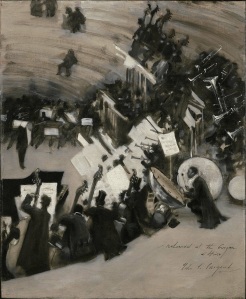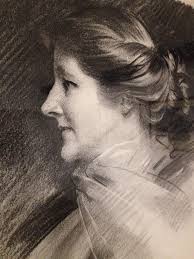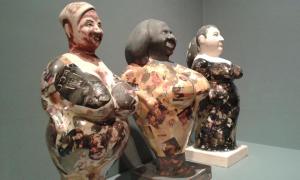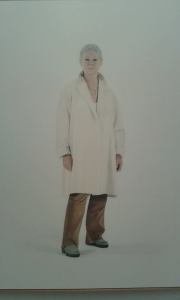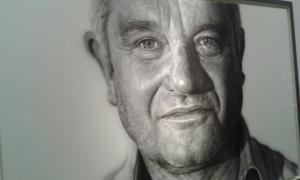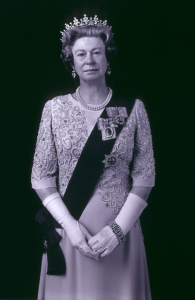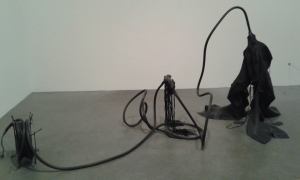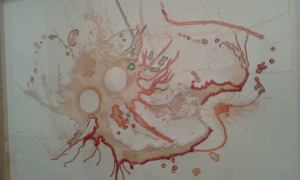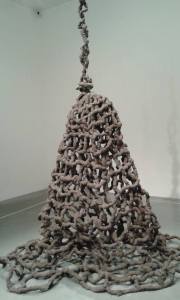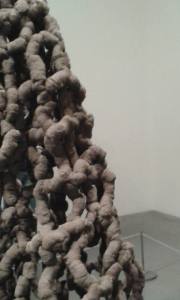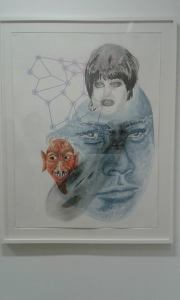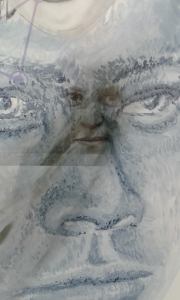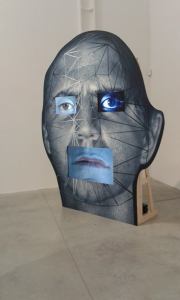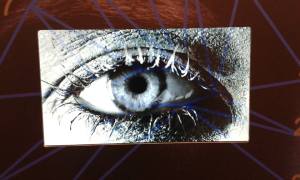London 19/1/15
Posted: February 26, 2015 Filed under: Contextualisation, Subject, Third Year | Tags: art, artist research, contemporary, contextualisation Leave a commentNational Portrait Gallery
I haven’t been to the National Portrait Gallery in such a long time. I’m not particularly interested by realistic paintings as the technology we have today can capture the same affect however I do appreciate ridiculous talent.
John Singer Sargent was an American artist from the Renaissance period. He was a deeply cultured man and the exhibition draws out the range of influences that helped shape his creative vision. Throughout his life Sargent painted portraits of artists, writers, actors and musicians, who were his friends. Such pictures were rarely commissioned and the artist was free to create more radical images than was possible in formal portraiture.The result is a selection of highly charged portraits that form a distinctive strand in Sargent’s work; intimate, peculiar and experimental.
In 1885, while Sargent was on a boating trip on the Thames, he saw what he described as a “paradisiac sight”: two little girls lighting paper lanterns at dusk in a garden planted with roses. This vision was the inspiration for this painting, painted during the late summer and autumn of 1885 and 1886 in Broadway,Worcestershire. French Impressionism, English Pre-Raphaelistism and Astheticism have influenced this painting, while the flower imagery references the Italian Renaissance and their poetic symbolism.
Probably one of his most well known pieces, Sargent explores the conditions of light at a particular time of day in this painting. I love the colours and how it reminds me of my childhood memories. I loved the idea of magic and fairies and used to hide fairy statues in my garden as a child. Similarly, it reminds me of a film based on two little girls who discovered that fairies exist,in the bottom of the garden. It is as if I am looking at an old memory.
This study of rehearsal life is one of a very small number of depictions that Sargent made of contemporary city life. The Cirque d’Hiver is a small amphitheatre in the 11th arrondissement of Paris. Pasdeloup’s classical concerts were popular in 1861. Pasdeloup’s programme was adventurous and his policy of cheap seating helped to create a new audience, promoting the composition of new French symphonic works and making Wagner’s music known in France.
I love this painting as it displays movement and captures the atmosphere of the orchestra. As I was looking at the painting, I felt as if I became the audience of the orchestra. You can never take your eyes off an orchestra, the talent that the musicians have and the music they produce. I was drawn to this painting as it was the only monochromatic painting in the room. It was also the only one of multiple people which I found engaging.
Mary Antoinette Anderson (1859-1940) was an American actress known for her performance as Juliet in Shakespeare’s play. Two years later she appeared on stage as Lady Macbeth before embarking on a lengthy American tour. She was admired for her beauty and her dramatic talent. In 1889 she married Antonio de Navarro, a fellow wealthy American and they moved to Broadway, Worcestershire; the village where Sargent had painted “Carnation, Lily, Lily, Rose.”
I particularly liked this drawing as it was drawn simply in one material. The charcoal does not affect the picture with dark, scruffy lines but gives the image a soft, more feminine feel to it. Anderson has been drawn incredibly and she has a familiarity to my Aunt which I love. I also like how Anderson’s hair has been drawn in the opposite direction to the background and items of clothing which gives the picture a still movement.
Grayson Perry‘s “Who Are You?” exhibition displays new works including a self portrait and a tapestry made during his Channel 4 series “Who Are You?”
These three women, big and proud who want their size to be seen as a positive. Perry portrayed them as antique figures covered with images of female perfection and food. In history of sculpture, female forms were often seen as fertility goddesses to be prayed upon for children and plentiful harvests. These days, the female figure are more likely under the microscope for growing health problems.
This piece of work is very influential for me. I have a big figure but I am more towards wanting myself to see my size as a positive rather than other people. I would prefer other people to dislike my body and for me to love it, whereas at the moment I feel that others don’t take notice and I am very aware of my size. This feeling has become more noticeable with my work, as I am focusing on my body and how I perceive it with photographs and collage.
Alessandro Raho “Dame Judi Dench,” oil on canvas
Jason Brooks “Paul,” acrylic on canvas
Hiroshi Sugimoto “Queen Elizabeth 2” Gelatin silver print laid on aluminium
I chose these three artists and their work in particular as I thought they were the most realistic and I preferred them the most (except Marc Quinn self portrait, which I couldn’t get a good enough photograph due to lighting.) I love Raho’s painting of Dame Judi Dench. Although painted with oil, the painting doesn’t seem heavy but soft and light, like she’s floating above the canvas. Brooks’s painting of Sir Paul Nurse is incredible. When I first saw it I thought it was a photograph but when you look closely, the edges of his face seem to blur and fade into the background. It is possibly one of the best contemporary paintings I have ever seen.
Tate Modern
I was recommended to go see Marlene Dumas by my friends and peers. Dumas’ intense, psychologically-charged works explore themes such as sexuality, love, death and shame, often making reference to art history, popular culture and current affairs. She never paints directly from life, instead choosing to use pre-existing images for her source material.
“Rejects,” is a series of ink and graphite “portrait heads” pinned directly to the wall. It began with images Dumas had discarded from another piece of work. This reminded Dumas of the “reject-stores” in South Africa that sold clothes with imperfections. By bringing these “rejects” together, Dumas made the artistic process of selection and judgement visible, perhaps implying a parallel with the ways in which society accepts some and excludes others.
I love this piece and it is probably my favourite from the whole of her exhibition. I found the faces intriguing as they all represent something different. I enjoying using ink in my own work, how it disperses onto wet paper and I feel that Dumas might have used ink for the same reason – the “reject” is able to disperse from the paper and how it is seen.
At the turn of the century, Dumas moved towards representations of war. She used images of dead terrorists, martyrs, suspects and look-alikes, as well as the escalation of conflicts in the Middle East. Rather than focus only on contemporary source images, she often returned to earlier material to express a mixture of personal anxiety and universal tragedy.
In “Dead Girl,” Dumas returned to a clipping from the 1970’s of a young woman who has attempted to hijack a plane and was killed. This painting is a reminder of political history of contemporary charged events and the representation of the female body during conflict and war.
Louise Bourgeois
Although Bourgeois is recognised for her ambitious sculptures, she produced a large body of works on paper throughout her lifetime. Drawing and printmaking were important aspects in her practice. The exhibition at Tate Modern shows how she reworked ideas from earlier in her career, using drawings and parables to create books of engravings or to explore auto biographical scenes.
Gouache on paper, “The Birth,” is beautiful, graphic, raw and instinctive. Bourgeois often depicts the female form as an abstracted fertility form often encountered in ancient civilizations reminding us that even with our modern day technology, childbirth is just as primordial as it ever was.
This particular piece reminds me of Tracey Emin and the concept of “leaky bodies.” I love that the body shows the birth with a light colour. I feel that the gouache aids the idea that the body leaks out the baby, that the baby is not the main object in this piece.
I really liked “Look Up!” 2009 an etching on paper. I found that most of her drawings and prints seemed botanical, but in particular, “Look Up!” reminded me of a bean stalk – but not like ones from fairytales. Literally a stalk made from beans. I liked that each individual ‘bean’ was different, not in size or shape but in colour and definition.
Energy and Process
I only went to the energy and process exhibition and not the structure and clarity exhibition. This was down to time management – the bus was late arriving in London due to an accident. The exhibition displays artists interests in transformation and natural forces. The Italian artists of Arte Povera produced work that explored changing physical states instead of representing things in the world, while in Japan and the United States the Mono Ha and Post Minimalism movements looked for alternatives to a sleek technological aesthetic.
Nicholas Hlobo
Hlobo weaves, plaits and stitches together disparate materials to create intricate and seductively tactile sculptures and drawings. He titles his work in his native language Xhosa, an Nguni language spoken in South Africa. Attracted to the formal qualities of the grammar, the sounds of the words, and the linguistic flexibility of Xhosa, Hlobo’s use of the language, with all its poetic idioms, proverbs, and double entendres, is as much about defining himself as it is an effort to emphasise the challenges of openly talking about homosexuality in South Africa.
“Macaleni Lintozomlambo,” tea and ribbon on paper. The tea stain forms the base for the drawing. The tentacles of stitch and ribbon are emphasised by orange and red stitches and they are defined by light coloured ribbon. Sexual connotations are present in this piece, the fleshy tones and slippery surface.The title refers to a tradition of an Xhosa belief, where boys throw rocks into the river before skinny dipping as a sign of respect to the river.
I particularly liked this piece due to the colour and sea animal tendency. I thought the piece felt as if something was drowning, the white circles representing dead eyes, the tentacles floating as water overpowers the animal. Although my concept of the piece was morbid and isn’t reflected in the representation of the Xhosa belief, I can see how water and flesh is combined.
Pino Pascali
Made using steel wool,Pascali’s Trap evokes the rope traps used to hunt animals in adventure stories and Tarzan films.
Pino Pascali was one of the most important Italian artists of the 1960s and took part in the first Arte Povera shows but he was killed in a motorcycle crash in 1968. Sceptical of artists who adopted a consistent style, Pascali attempted to change the materials and themes of his work with every new show. Trap was from his penultimate group of sculptures, the Reconstructions of Nature series, shown at the Attico Gallery in Rome in 1968.
I particularly liked this piece due to the complexity of it. The intertwined structure of a maze, a simple idea into a difficult sculpture is fascinating. I like how the title represents how it is seen and perceived. Also I find that as the colour of the wool is a sludgy brown, it could easily be exhibited outside, as part of a landscape. A maze is a hidden object, where the route is only seen from birds eye view, whereas this is easily seen as a complex sculpture with no way out.
Lisson Gallery
This exhibition centres around his fascination with the evolution of identity via techniques of facial recognition technology.His interest in the face as the locus of communication and identity, through features, movements and expression, is central to these works. Tony Oursler‘s main installation reflects an ongoing body of multimedia works related to mimetic technology and its effect on contemporary psychology.
I love the ghost tearing off the inner face in “Less-than-perfect.” I feel that it gives an eerie approach to a piece of work that I see as rather humorous. I find it humorous as Oursler has complimented his take on the devil with Kelly Osbourne – the daughter of Ozzy Osbourne – known for being lead vocalist to Black Sabbath and a TV personality. Growing up, I only really knew him for being the guy who bit the head off a bat – devil-ish type of man.

